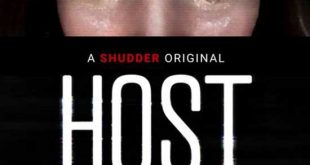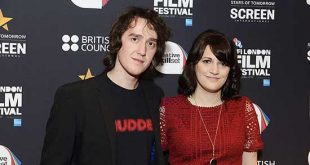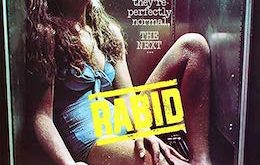One of the most successful short films of 2016 found audiences from around the world and selected to such film festivals as “Fantasia”, “Fantastic Fest” & the “Morbdio Film Festival” to name just a few. Powerful, genre re-inventing and so well crafted with multiple story arcs feeding into the final moments before a pulse is unleashed in London. It takes many to create any sort of film project but in this case takes one to lead them. The man and the mind behind this multi-layered, short form storytelling is Rob Savage. Rob took sometime out to talk with Jay Kay of the “HorrorNews.net” in this first of a two part conversation about authentic performance, influences that impact and having strong parts to create memorable storytelling.
Thank you Rob for taking some time out to talk “Dawn of the Deaf”. There are very few short form films that affect me as your project did. Talk first where the inspiration and story came from for your short? Was it at all personal? Were you at all influenced by a film like “The Signal” or Stephen King’s novel “Cell”?
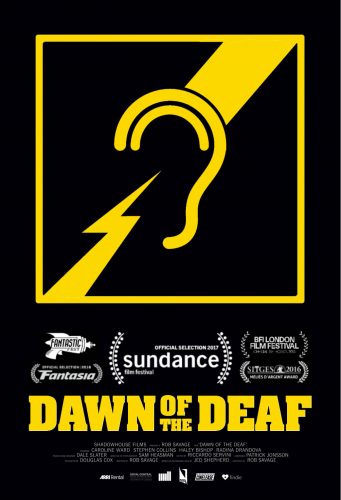
Rob Savage: No problem! Thanks for all your support of the film, Jay. I’ve wanted to make a zombie movie since I was about twelve years old, when I snuck downstairs in the middle of the night and watched “Night of the Living Dead” while my parents were asleep. I was pretty obsessed with Romero’s trilogy as a teenager, but like everyone else, I got pretty worn down by all the repetitive, sub-par zombie films that were being churned out. I knew that if I were ever to make a zombie film, it would have to be a really striking idea.
I was getting drinks with horror-buff, writer, record producer and all-round-busiest-man-I-know Jed Shepherd, and he pitched me the idea of a Deaf-led zombie movie where the infection is spread through sound, and I knew right away that it was the idea I’d been waiting for. We developed the idea from there and began work on the short. I watched “The Signal” when it first came out, and really enjoyed it, but it wasn’t a conscious reference. “Cell” was a much more deliberate inspiration. The book isn’t necessarily up there with King’s best stuff, but there are moments of such wonderful weirdness that have really stuck with me – like the zombies “charging” themselves in the football field.
You’ve been to every single impactful genre film festival during the run of “Dawn of the Deaf”. How has the overall process and selections been for “Dawn of the Deaf”. and the support of festivals, peers and fans?
RS: It’s been incredible. Part of the reason we made the short film was to gain support and interest in the feature film version and so it’s been amazing to have found such support and excitement from the horror and wider film community. We’ve also managed to play at both amazing genre festivals, like Fantasia, Sitges and Fantastic Fest, and prestige mainstream festivals like BFI London and Sundance.
“Dawn of the Deaf”. opens an hour before a pulse hits London. You offer four snapshots of different character facing moments in their life both incredible to disturbing that tie into the narrative overall. How many possible story arcs did you choose from before narrowing it down to the final four? Why was the camcorder segment selected?
RS: “Dawn of the Deaf” was made for almost no budget, and so we designed the four arcs to best serve the budget, as well as to illustrate different aspects of Deaf culture. The girls’ argument in the tunnel came first – this was an image that came to me straight away as Jed pitched me the concept. I loved the idea of an audience assuming that the characters were uncomfortable in their Deafness, but actually be arguing about something totally different. The father/daughter strand came out of a lot of very uncomfortable research, especially into the case that Alex Gibney explored in his film Mea Maxima Culpa. Kevin and the community awards strand came from the desire to stage a large scale set piece involving as many extras as we could secure. If you promise a zombie movie, you have to deliver – and that means giving the audience a proper sense of scale.
Also, from spending time with members of the Deaf community, I was interested in having a character who communicated verbally. We wanted this strand to feel like the final scene in a cheesy, inspirational movie about overcoming adversity… only to have it descend into bloodshed. Finally, we added the phone footage because it was a very cheap way of offering another perspective and giving the audience a couple of asshole characters who they could ENJOY seeing get killed and zombified, as opposed to the rest of the cast who you want to survive the film.
 What was the casting like for “Dawn of the Deaf”? Talk about having an authentic feel to the short form film on many different levels?
What was the casting like for “Dawn of the Deaf”? Talk about having an authentic feel to the short form film on many different levels?
RS: Part of the funding for “Dawn of the Deaf” came from the drama school The Royal Central School of Speech and Drama, who provided money on the basis that we use a handful of their students. We auditioned for a few days, seeing 30 students and settling on our leads. We made it clear from the start that if we were going to be as authentic and respectful as possible, they would need to practice every day – we put them through three months of sign language coaching with our British Sign Language Consultant Samuel Dore. We also knew that it was important to work with Deaf acting talent on the film, and so made sure to run a separate casting for Deaf actors. The film uses a mixture of Deaf and Hearing talent, although for the feature version of the film we are committed to using entirely Deaf actors.
Many performers take on roles that are acting. They are not deaf, mute, ill, special needs, homosexual, a lesbian and such. They show great pride and study to be respectful to those communities in their performance. You address the aspect of being hearing impaired or deaf in “Dawn of the Deaf” in several capacities connecting it to the overall story. What was it like on set communicating? What has the reaction been to the short film from the deaf community?
RS: The reaction has been overwhelmingly positive. While there will always be controversy about casting hearing actors in Deaf roles, we have met these criticisms head on. The producer, Douglas Cox, and I went on BBC See Hear, the premier Deaf news TV programmer and made it clear that our intention was to make a feature film version using Deaf actors, as well as explaining the lengths we went to in order to make the film as authentic as possible.
The film couldn’t have been made without the incredible work and input of Samuel Dore, a fantastic Deaf filmmaker who came on board as our British Sign Language Consultant and oversaw the project from first draft to final edit.
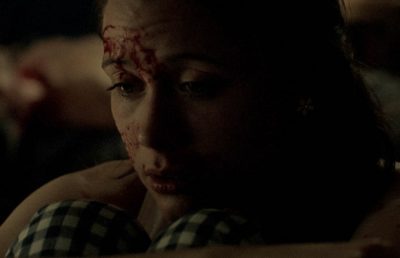
Each of the segments stand on their own as individual stories that connect. In the opening segment of “Dawn of the Deaf”, you show great misdirection on many levels with the father and daughter time together. It is so powerful, effective and so deceitful making you feel very uneasy. Without giving away too much, can you tell me why you chose the father/daughter story to open it up rather than the other three?
RS: I think that in most of the best horror films, and certainly in Romero’s work, it’s the humans who are ultimately more monstrous than the creatures. This is certainly true of “Dawn of the Deaf”, and is testament to the amazing work of the actors Chris Curran and Caroline Ward. It always felt like the film had to begin with Sam and her dad. Sam has undergone such horrors already, and continues to throughout the film, that the audience naturally latch on to her character in a very powerful way. Her character also has the greatest arc in the film, culminating in her attempt to end the cycle of violence. In the script, the film began with the arguing girls, but in the edit we discovered that the heart of the film lay in Sam’s story.
What was the editing like for “Dawn of the Deaf”? When did the final idea of the captions fully come into form? Also, give insight into the cutting of the episodes to tell their individual stories leading up to the moment?
RS: Riccardo Servini, the editor, and I spent a lot of time playing around with the structure of the film. We wanted “Dawn of the Deaf” to have a sense of scale and forward momentum, but wanted to be careful not to over-edit the sections of the film, which might have hindered the audience emotionally investing in the characters. The hardest section to get right was the build up to the “Pulse” going off. Part of the film’s design was to make the audience forget that they were watching a horror film – to draw them into the characters’ stories and then surprise them as the film descends into horror. The pace of the film slows down as the girls are arguing, since we shot the scene in an unbroken steadicam shot, so we had to made sure that the edit ramped up after the reveal of the dead bodies. This took a lot of work, but always plays amazingly well with audiences.
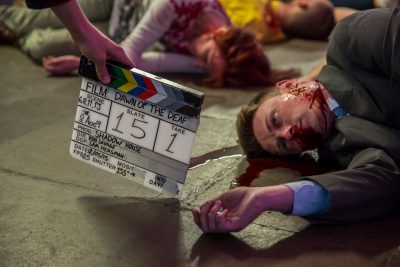 Once segment in particular, talk also about the deaf couple arguing in sign language and captions. Why go with the blocking like you do as if the crowd and noise is cutting through their exchange?
Once segment in particular, talk also about the deaf couple arguing in sign language and captions. Why go with the blocking like you do as if the crowd and noise is cutting through their exchange?
RS: This came as part of a discussion with Samuel Dore about how to shoot BSL (British Sign Language) — there is one school of thought which believes that BSL should be shot to always include the hands and face of the person signing, forgoing close-ups and cutaways. I chose a more conventional shooting style, but included that moment as a reference to filmmakers who shoot in a “sign-safe” style — when the audience cannot see hands and face, we deny them the subtitles.
Look for part 2 of the interview with filmmaker Rob Savage next week here on the “HorrorNews.net“. Until then, check out the trailer for “Dawn of the Deaf” https://www.youtube.com/watch?v=lgZqq2noLUg&feature=youtu.be & more at the IMDB http://www.imdb.com/title/tt5644824/releaseinfo?ref_=tt_dt_dt
 Horror News | HNN Official Site | Horror Movies,Trailers, Reviews
Horror News | HNN Official Site | Horror Movies,Trailers, Reviews

